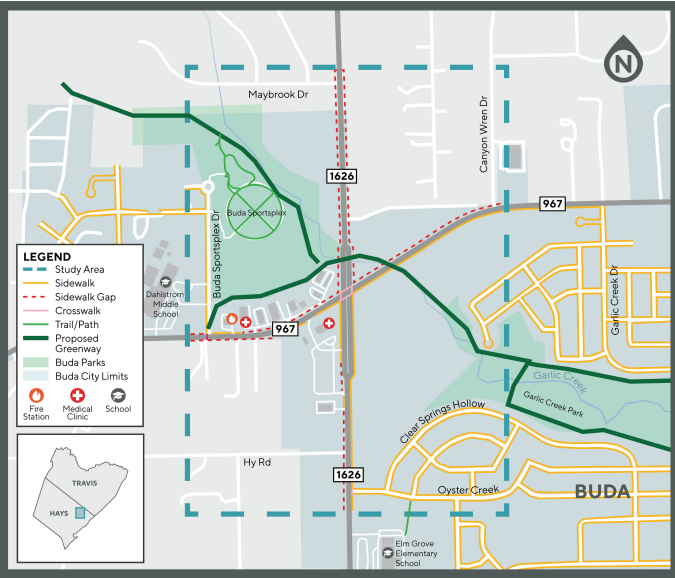BUDA — The Capital Area Metropolitan Planning Organization (CAMPO) and the city of Buda are working together to identify, evaluate and recommend potential improvements for the FM 1626 and RM 967 intersection through the form of a study.

The intersection connects two essential commuter roads in Hays County, according to CAMPO, as FM 1626 functions as the primary northsouth route in eastern Hays County, paralleling IH-35, while RM 967 serves as the principal east-west corridor in the area. CAMPO and the city of Buda are conducting this study to identify safety and mobility enhancements and plan as the region continues to grow.
The study will use public input to help CAMPO and the city of Buda define and identify feasible options for improvements to FM 1626 and RM 967. The study will include an analysis of current and projected traffic volumes, crash hotspots, environmental features, needs and concerns identified in stakeholder and public input and will result in recommendations for improvements, according to CAMPO.
The main study goals and objectives include the following:
• Identify and recommend solutions to improve safety: Evaluate and consider crash data, intersection improvements, bicycle and pedestrian travel and input from the community.
• Enhance mobility and functionality of the intersection: Improve traffic operations to create a reliable and consistent network for the movement of people and goods through and within the intersection and improve access to adjacent businesses, neighborhoods and schools.
• Enhance multimodal movement, operations and safety: Consider and plan for transportation needs for multimodal use of the intersection, including improving facilities for bicyclists, pedestrians and transit.
• Develop community-supported recommendations for the intersection: Employ strategies to maximize participation across diverse audiences that reflect the community, including outreach to underreached communities and those with limited English proficiency; consider and incorporate feedback from the community in each step of the study development process.
According to a crash summary for the study, there were 205 total crashes were reported in the study area between January 2019 and September 2024. The summary also found the following:
• 55% of crashes occurred at or near intersections within the study area
• 82% of crashes resulted in no injuries, while less than 3% involved serious injuries
• 27% of crashes involved leftturn collisions, with a large number happening at or near the FM 1626 and RM 967 intersection
• 22% of crashes involved one vehicle going straight while another made a left turn from the opposite direction (one straight – one left), with another 20% of crashes occurring when one vehicle traveling straight rear-ended another vehicle that was stopped (one straight – one stopped) In addition to an analysis of the existing roads and safety conditions, the project team will consider environmental features, such as natural, human and water resources, historical resources and community resources when developing improvements, according to CAMPO.
The project is currently in the data collection and analysis stage, as CAMPO and the city of Buda recently held an in-person open house on Jan. 30 and a virtual open house is still available through March 7 at bit.ly/FM1626RM967.
Following that, according to CAMPO, the project timeline is: 1. Develop Potential Improvements (Spring 2025):
• Use input and technical analyses from previous steps to identify and develop potential improvements to the FM 1626/RM 967 intersection
• Establish evaluation criteria and quantify the impacts and features for each potential improvement concept
• Collect input from the community on potential improvement concepts, including a no-build option 2. Recommend Improvements and
Prepare Final Report (Summer 2025): • Use public input from previous steps to refine potential improvements
• Submit final report that includes recommendations for improvements, project materials and an implementation plan Future project development phasing to advance recommendations from this study is a multi-year process that will require additional funding. Additional phases will include gathering more community input and may also include detailed design, right-of-way acquisition and utility coordination and construction.
To learn more about the FM 1626/RM 967 study, visit bit.ly/4jGfFBI.










